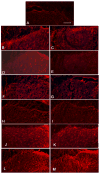Chemical and mechanical nerve root insults induce differential behavioral sensitivity and glial activation that are enhanced in combination
- PMID: 17920051
- PMCID: PMC2174426
- DOI: 10.1016/j.brainres.2007.08.064
Chemical and mechanical nerve root insults induce differential behavioral sensitivity and glial activation that are enhanced in combination
Abstract
Both chemical irritation and mechanical compression affect radicular pain from disc herniation. However, relative effects of these insults on pain symptoms are unclear. This study investigated chemical and mechanical contributions for painful cervical nerve root injury. Accordingly, the C7 nerve root separately underwent chromic gut exposure, 10gf compression, or their combination. Mechanical allodynia was assessed, and glial reactivity in the C7 spinal cord tissue was assayed at days 1 and 7 by immunohistochemistry using GFAP and OX-42 as markers of astrocytes and microglia, respectively. Both chromic gut irritation and 10gf compression produced ipsilateral increases in allodynia over sham (p<0.048); combining the two insults significantly (p<0.027) increased ipsilateral allodynia compared to either insult alone. Behavioral hypersensitivity was also produced in the contralateral forepaw for all injuries, but only the combined insult was significantly increased over sham (p<0.031). Astrocytic activation was significantly increased over normal (p<0.001) in the ipsilateral dorsal horn at 1 day after either compression or the combined injury. By day 7, GFAP-reactivity was further increased for the combined injury compared to day 1 (p<0.001). In contrast, spinal OX-42 staining was generally variable, with only mild activation at day 1. By day 7 after the combined injury, there were significant (p<0.003) bilateral increases in OX-42 staining over normal. Spinal astrocytic and microglial reactivity follow different patterns after chemical root irritation, compression, and a combined insult. The combination of transient compression and chemical irritation produces sustained bilateral hypersensitivity, sustained ipsilateral spinal astrocytic activation and late onset bilateral spinal microglial activation.
Figures






Similar articles
-
Transient cervical nerve root compression in the rat induces bilateral forepaw allodynia and spinal glial activation: mechanical factors in painful neck injuries.Spine (Phila Pa 1976). 2005 Sep 1;30(17):1924-32. doi: 10.1097/01.brs.0000176239.72928.00. Spine (Phila Pa 1976). 2005. PMID: 16135981
-
Spinal glial activation and cytokine expression after lumbar root injury in the rat.Spine (Phila Pa 1976). 2000 May 15;25(10):1206-17. doi: 10.1097/00007632-200005150-00003. Spine (Phila Pa 1976). 2000. PMID: 10806496
-
Cytokine antagonism reduces pain and modulates spinal astrocytic reactivity after cervical nerve root compression.Ann Biomed Eng. 2010 Aug;38(8):2563-76. doi: 10.1007/s10439-010-0012-8. Epub 2010 Mar 23. Ann Biomed Eng. 2010. PMID: 20309734
-
Pathoanatomy and pathophysiology of nerve root compression.Spine (Phila Pa 1976). 1984 Jan-Feb;9(1):7-15. doi: 10.1097/00007632-198401000-00004. Spine (Phila Pa 1976). 1984. PMID: 6372124 Review.
-
Pathophysiology of disk-related sciatica. I.--Evidence supporting a chemical component.Joint Bone Spine. 2006 Mar;73(2):151-8. doi: 10.1016/j.jbspin.2005.03.003. Epub 2005 Jun 22. Joint Bone Spine. 2006. PMID: 16046173 Review.
Cited by
-
Whiplash-like facet joint loading initiates glutamatergic responses in the DRG and spinal cord associated with behavioral hypersensitivity.Brain Res. 2012 Jun 21;1461:51-63. doi: 10.1016/j.brainres.2012.04.026. Epub 2012 Apr 21. Brain Res. 2012. PMID: 22578356 Free PMC article.
-
Spontaneous inflammatory pain model from a mouse line with N-ethyl-N-nitrosourea mutagenesis.J Biomed Sci. 2012 May 30;19(1):55. doi: 10.1186/1423-0127-19-55. J Biomed Sci. 2012. PMID: 22646813 Free PMC article.
-
Salmon-derived thrombin inhibits development of chronic pain through an endothelial barrier protective mechanism dependent on APC.Biomaterials. 2016 Feb;80:96-105. doi: 10.1016/j.biomaterials.2015.11.062. Epub 2015 Dec 2. Biomaterials. 2016. PMID: 26708087 Free PMC article.
-
[Entrapment neuropathies: a contemporary approach to pathophysiology, clinical assessment, and management : German version].Schmerz. 2021 Dec;35(6):419-433. doi: 10.1007/s00482-021-00584-z. Epub 2021 Sep 10. Schmerz. 2021. PMID: 34505948 Review. German.
-
The prostaglandin E2 receptor, EP2, is upregulated in the dorsal root ganglion after painful cervical facet joint injury in the rat.Spine (Phila Pa 1976). 2013 Feb 1;38(3):217-22. doi: 10.1097/BRS.0b013e3182685ba1. Spine (Phila Pa 1976). 2013. PMID: 22789984 Free PMC article.
References
-
- Abbadie C, Brown JL, Mantyh PW, Basbaum AI. Spinal cord substance P receptor immunoreactivity increases in both inflammatory and nerve injury models of persistent pain. Neurosci. 1996;70:201–209. - PubMed
-
- Aoki Y, Rydevik B, Kikuchi S, Olmarker K. Local application of disc-related cytokines on spinal nerve roots. Spine. 2002;27:1614–1617. - PubMed
-
- Araujo MC, Sinnott CJ, Strichartz GR. Multiple phases of relief from experimental mechanical allodynia by systemic lidocaine: responses to early and late infusions. Pain. 2003;103:21–29. - PubMed
-
- Atlas SJ, Keller RB, Wu YA, Deyo RA, Singer DE. Long-term outcomes of surgical and nonsurgical management of sciatica secondary to a lumbar disc herniation: 10 year results from the Maine lumbar spine study. Spine. 2005;30:927–935. - PubMed
-
- Boos N, Rieder R, Schade V, Spratt KF, Semmer N, Aebi M. 1995 Volvo award in clinical sciences: The diagnostic accuracy of magnetic resonance imaging, work perception, and psychosocial factors in identifying symptomatic disc herniations. Spine. 1995;20:2613–2625. - PubMed
Publication types
MeSH terms
Grants and funding
LinkOut - more resources
Full Text Sources
Miscellaneous

